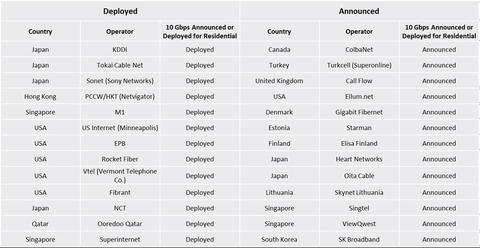
While you were sleeping, 10G to the home happened in some countries.
While you were sleeping.
Yes, much of America was fast asleep when the U.S. women’s hockey team won the gold medal during the recent Winter Olympics. Similarly, much of America has been dozing while service providers in Japan compete on offering the fastest and least expensive FTTH services. Several Japanese service providers are supporting 10 Gbps (10G) FTTH services at under $100 per month and KDDI recently announced its 10G symmetrical service, also under $100 per month.
The low cost sets Japan apart.
10G to the home is not new. More than 30 operators have announced or are deploying 10G downstream FTTH services and many are listed in Table 1.
Table 1: 30 operators have announced or deployed 10G downstream FTTH services

Source: Ovum
Within those 30 service providers, nine operators are supporting 10G symmetrical FTTH, including:
- KDDI (Japan)
- NCT (Japan)
- Ooredoo (Qatar)
- Superinternet (Singapore)
- EPB (USA)
- Fibrant (USA)
- Rocket Fiber (USA)
- US Internet (USA)
- Vtel (USA)
But what sets Japan apart is the monthly fee or tariff. KDDI, with 10G symmetrical, and Sony Networks, with 10G downstream, are offering their respective services at less than $100 per month. They are targeting residential customers with low tariffs. This is in contrast to other operators around the globe that are willing to support residential customers with 10G services but with business-like tariffs.
The residential marketing war in Japan leaps to 10G
Just several years ago, Google Fiber waged a marketing war in the U.S. around 1 Gbps (1G). Today, there are more than 100 operators offering gigabit services around the globe. As eloquently stated by Ovum’s Broadband and Multi-play senior analyst Kamalini Ganguly, “with gigabit, telcos can differentiate on speed and project an image of technology leadership, especially in countries with multiple FTTP operators. In addition, telcos could command a price premium with 10G services.”
But Japan’s operators seem to have skipped over the 1G marketing war and set the battle lines at 10G with truly residential pricing. There are likely reasons for the new battle lines. The first reason is simply service differentiation. Japan boasts one of the highest FTTH household penetration rates in the world at over 60% and the vast majority of the country’s households have access to FTTH services.
Another driver for 10G is 4K TV content, which is experiencing rapid adoption in Japan and requires more bandwidth. Ovum forecasts that 15.58 million households, or 30% of the total market, will have a 4K UHD TV in 2020. The operator NHK began the world's first 8K TV broadcasts in August 2016 and is preparing to launch full-scale 8K transmissions for the 2020 Tokyo Olympics.
Low residential tariffs will not pay for 10G FTTH
Japan is relying on both local and foreign communications equipment vendors for 10G PON solutions including NEC, Sumitomo, Mitsubishi and Fujitsu for 10G EPON equipment and Huawei and ZTE for 10G GPON (XG-PON1) equipment. Regardless, low monthly tariffs ensure a longer payback or monetization period versus higher tariffs even when the underlying ODN (optical distribution network) is in place.
Ovum estimates that 10G EPON ONTs currently cost around 4X the cost of EPON ONTs primarily due to the higher optics costs. The cost differential is even higher when comparing XGS-PON ONTs or XG-PON1 ONTs to GPON ONTs. In addition, 10G OLTs cost more than GPON or EPON OLTs.
While operators in Japan may have longer-term financial outlooks or monetization timeframes than those in other countries, their shareholders expect profitability.
Look to 5G and the Olympics for monetization
But what does 10G PON have to do with 5G or the Olympics? The push for 5G requires a very strong wireline transport and access network. Several operators are evaluating the use of PON, particularly next-gen PON, to support 5G fronthaul. For example, one project within the Broadband Forum is investigating the disaggregation of PON functions, separating those with time-critical functions to those without. Both MFH (mobile fronthaul) and MBH (mobile backhaul) require time-critical functions to ensure low latency.
5G networking technology played a central role at the 2018 Winter Olympics in PyeongChang and we can expect it to play an even larger role at the 2020 Summer Olympics. Perhaps network monetization will come later, with Japanese residences benefiting from low-cost 10G FTTH services today.
Julie Kunstler is a Principal Analyst at Ovum specializing in wireline/fixed broadband access, particularly next-generation broadband technologies, deployments and monetization strategies.
